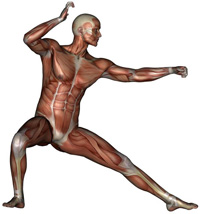
Key Points
- The most common is acute trauma from a direct force, such as landing on the point of the shoulder, or from an indirect force, such as falling on an outstretched hand.
- Individuals who complain of pain at the top or front of the shoulder during overhead activity or discomfort during chest activities should be evaluated by a medical professional.
- Self-myofascial release for the lats, and thoracic spine, in combination with an integrated flexibility program for the lats and pecs can help create better range of motion.
Shoulder injuries may have many different mechanisms or pathologies. The most common is acute trauma from a direct force, such as landing on the point of the shoulder, or from an indirect force, such as falling on an outstretched hand. Either of these mechanisms may result in fractures of the humerus, clavicle, scapular body, and glenoid fossa, or dislocations and tears of capsular ligaments or labrum. However, the most commonly seen injuries in athletes or the active population stem from pattern overload or overuse syndromes.
Overuse injuries are those caused by repetitive submaximal stress that surpasses overall tissue integrity or the natural repair processes of the involved tissues. People who are predisposed to these injuries are those who exhibit an upper extremity postural distortion (UEPD). UEPD is defined by a forward head, forward rolled shoulders (stemming from over-tight pectoralis major , latissimus dorsi , and scalenes), and elongated external rotators ( infraspinatus , teres minor) and rhomboids .
Overuse injuries are often the result of a snowball effect that is caused by either pattern overload, orovertraining . For example, if a thrower tries to increase ball speed by working the muscles of the shoulder that produce internal rotation or anterior movement more than the stabilizers of the shoulder (external rotators), these stabilizers become reciprocally inhibited and fail to stabilize during functional movement (throwing). Without that stabilizing mechanism, the athlete may develop a subacromial impingement, leading to subacromial bursitis, rotator cuff tendonitis, and possible tears of the external rotators.
What are the symptoms?
Individuals who complain of pain at the top or front of the shoulder during overhead activity (such as shoulder presses) or discomfort during chest activities (such as presses or flys) should be evaluated by a medical professional. For individuals who complain of tenderness on the outside of the shoulder where the deltoid inserts into the humerus, health and fitness professionals should alter the activity that is causing this discomfort and refer the client out to a qualified professional for evaluation.
How to avoid a potential shoulder injury:
Utilizing the overhead squat, health and fitness professionals need to make sure they assess these clients to identify such imbalances, and subsequently develop corrective exercises to address the overall problem.
Self-myofascial release for the lats, and thoracic spine, in combination with an integrated flexibility program for the lats and pecs can help create better range of motion (ROM) surrounding the glenohumeral joint. This increased ROM will help the body recruit muscles such as the rhomboids and mid /low traps (antagonists to the pecs and anterior deltoid ) which are paramount in helping to control the actions of the shoulder joints.
Utilizing a strengthening program directed first at focusing on the stabilizing muscles (such as the rotator cuff) and then integrating these stabilization exercises with strength movements for the deltoids, rhomboids and mid/low traps will help increase control over the new range of motion, create postural balance, and establish proper movement surrounding the shoulder joint. This type of training is integral for preventing these types of shoulder injuries before the problem starts.
Try these exercises to help strengthen the rotator cuff:
Isolated Strengthening:
1. Cable or Tubing External Rotation
Integrated Strengthening:
3. Ball cobra



